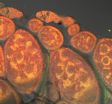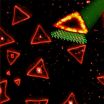(Press-News.org) Alexandria, VA –Scientists are revisiting the age-old question of how Earth's moon formed with the development of two new models that work out the complicated physics of planetary collisions. The idea of a moon-forming collision is not new: The Giant Impact Theory put forth in the 1970s suggested that the moon resulted from a collision with a protoplanet approximately half the size of ancient Earth. But the physics underlying such a collision implied that the moon should be made up of debris mostly from the protoplanet. Since then we've discovered the moon is instead very chemically similar to Earth. Now, scientists have come up with two new models that explain how an impact could have resulted in a moon formed from Earth material.
In one model, Robin Canup, an astrophysicist at the Southwest Research Institute in Boulder, Colo., suggests a much larger impactor than previously considered possible. However, in another model, astrophysicists Matija Ćuk and Sarah Stewart of Harvard University postulate that that a smaller impactor could still create the same effect if Earth was rotating much faster billions of years ago. Will these models help unlock the secret of how our moon formed? Read the story and find out at http://bit.ly/WjE8Po.
###
Check out this story and more all in the February issue of EARTH Magazine. Discover a hot new "Earth" circling the nearest star system; see how landslides revealed the reach of Virginia's recent earthquake; and learn if a deep-ocean impact kick-started the Pleistocene Ice Ages all in this month's issue of Earth!
Keep up to date with the latest happenings in Earth, energy and environment news with EARTH magazine online at http://www.earthmagazine.org/. Published by the American Geosciences Institute, EARTH is your source for the science behind the headlines.
The American Geosciences Institute is a nonprofit federation of geoscientific and professional associations that represents more than 250,000 geologists, geophysicists and other earth scientists. Founded in 1948, AGI provides information services to geoscientists, serves as a voice of shared interests in the profession, plays a major role in strengthening geoscience education, and strives to increase public awareness of the vital role the geosciences play in society's use of resources, resiliency to natural hazards, and interaction with the environment.
EARTH: Moon could have formed from Earth after all
Revising and revisiting the Giant Impact Theory
2013-02-05
ELSE PRESS RELEASES FROM THIS DATE:
Mitochondrial mutations: When the cell's 2 genomes collide
2013-02-05
PROVIDENCE, R.I. [Brown University] — Diseases from a mutation in one genome are complicated enough, but some illnesses arise from errant interactions between two genomes: the DNA in the nucleus and in the mitochondria. Scientists want to know more about how such genomic disconnects cause disease. In a step in that direction, scientists at Brown University and Indiana University have traced one such incompatibility in fruit flies down to the level of individual nucleotide mutations and describe how the genetic double whammy makes the flies sick.
"This has relevance to ...
Old age offers no protection from obesity's death grip
2013-02-05
Obesity kills, giving rise to a host of fatal diseases. This much is well known. But when it comes to seniors, a slew of prominent research has reported an "obesity paradox" that says, at age 65 and older, having an elevated BMI won't shorten your lifespan, and may even extend it. A new study takes another look at the numbers, finding the earlier research flawed. The paradox was a mirage: As obese Americans grow older, in fact, their risk of death climbs.
Ryan Masters, PhD, and Bruce Link, PhD, at Columbia University's Mailman School of Public Health, in collaboration ...
Giving transplanted cells a nanotech checkup
2013-02-05
Researchers at Johns Hopkins have devised a way to detect whether cells previously transplanted into a living animal are alive or dead, an innovation they say is likely to speed the development of cell replacement therapies for conditions such as liver failure and type 1 diabetes. As reported in the March issue of Nature Materials, the study used nanoscale pH sensors and magnetic resonance imaging (MRI) machines to tell if liver cells injected into mice survived over time.
"This technology has the potential to turn the human body into less of a black box and tell us if ...
Next-gen e-readers: Improved 'peacock' technology could lock in color for high-res displays
2013-02-05
ANN ARBOR—Iridescence, or sheen that shifts color depending on your viewing angle, is pretty in peacock feathers. But it's been a nuisance for engineers trying to mimic the birds' unique color mechanism to make high-resolution, reflective, color display screens.
Now, researchers at the University of Michigan have found a way to lock in so-called structural color, which is made with texture rather than chemicals. A paper on the work is published online in the current edition of the Nature journal Scientific Reports.
In a peacock's mother-of-pearl tail, precisely arranged ...
Samoan obesity epidemic starts at birth
2013-02-05
PROVIDENCE, R.I. [Brown University] — As some Pacific island cultures have "westernized" over the last several decades, among the changes has been a dramatic increase in obesity. Researchers don't understand all the reasons why, but even a decade ago in American Samoa 59 percent of men and 71 percent of women were obese. A new Brown University study finds that the Samoan epidemic of obesity may start with rapid weight gain in early infancy.
The implications of the study published online in the journal Pediatric Obesity may not be confined to Polynesian populations, said ...
Light-emitting triangles may have applications in optical technology
2013-02-05
For the first time, scientists have created single layers of a naturally occurring rare mineral called tungstenite, or WS2. The resulting sheet of stacked sulfur and tungsten atoms forms a honeycomb pattern of triangles that have been shown to have unusual light-emitting, or photoluminescent, properties. According to team leader Mauricio Terrones, a professor of physics and of materials science and engineering at Penn State, the triangular structures have potential applications in optical technology; for example, for use in light detectors and lasers. The results of the ...
Some omega-3 oils better than others for protection against liver disease
2013-02-05
CORVALLIS, Ore. – Research at Oregon State University has found that one particular omega-3 fatty acid has a powerful effect in preventing liver inflammation and fibrosis – common problems that are steadily rising along with the number of Americans who are overweight.
The American Liver Foundation has estimated that about 25 percent of the nation's population, and 75 percent of those who are obese, have nonalcoholic fatty liver disease. This early-stage health condition can sometimes progress to more serious, even fatal diseases, including nonalcoholic steatohepatitis, ...
Tendency to fear is strong political influence
2013-02-05
It's no secret that fear is a mechanism often used in political campaigns to steer public opinion on hot-button issues like immigration and war. But not everyone is equally predisposed to be influenced by such a strategy, according to new research by Rose McDermott, professor of political science, and colleagues published in the American Journal of Political Science.
By examining the different ways that fear manifests itself in individuals and its correlation to political attitudes, the researchers found that people who have a greater genetic liability to experience higher ...
Vitamin D, omega-3 may help clear amyloid plaques found in Alzheimer's
2013-02-05
A team of academic researchers has pinpointed how vitamin D3 and omega-3 fatty acids may enhance the immune system's ability to clear the brain of amyloid plaques, one of the hallmarks of Alzheimer's disease.
In a small pilot study published in the Feb. 5 issue of the Journal of Alzheimer's Disease, the scientists identified key genes and signaling networks regulated by vitamin D3 and the omega-3 fatty acid DHA (docosahexaenoic acid) that may help control inflammation and improve plaque clearance.
Previous laboratory work by the team helped clarify key mechanisms ...
JSCM publishes issue on NIDRR-funded project on practice-based evidence in SCI rehabilitation
2013-02-05
West Orange, NJ. February 4, 2013. The final phase of the SCIRehab Project (Phase 3) was published in the November 2012 issue of the Journal of Spinal Cord Medicine (JSCM). Nine papers comprised the Special Issue: Relationship of Inpatient Rehabilitation Interventions to Outcomes Following Spinal Cord Injury. Guest editors: J. Scott Richards, Gale Whiteneck, Daniel Lammertse, Marcel Dijkers, and Julie Gassaway. Key article available for free download via ingentaconnect.com: Whiteneck G, Gassaway J. The SCIRehab Project: What rehabilitation interventions are most strongly ...
LAST 30 PRESS RELEASES:
Air pollution exposure and birth weight
Obstructive sleep apnea risk and mental health conditions among older adults
How talking slows eye movements behind the wheel
The Ceramic Society of Japan’s Oxoate Ceramics Research Association launches new international book project
Heart-brain connection: international study reveals the role of the vagus nerve in keeping the heart young
Researchers identify Rb1 as a predictive biomarker for a new therapeutic strategy in some breast cancers
Survey reveals ethical gaps slowing AI adoption in pediatric surgery
Stimulant ADHD medications work differently than thought
AI overestimates how smart people are, according to HSE economists
HSE researchers create genome-wide map of quadruplexes
Scientists boost cell "powerhouses" to burn more calories
Automatic label checking: The missing step in making reliable medical AI
Low daily alcohol intake linked to 50% heightened mouth cancer risk in India
American Meteorological Society announces Rick Spinrad as 2026 President-Elect
Biomass-based carbon capture spotlighted in newly released global climate webinar recording
Illuminating invisible nano pollutants: advanced bioimaging tracks the full journey of emerging nanoscale contaminants in living systems
How does age affect recovery from spinal cord injury?
Novel AI tool offers prognosis for patients with head and neck cancer
Fathers’ microplastic exposure tied to their children’s metabolic problems
Research validates laboratory model for studying high-grade serous ovarian cancer
SIR 2026 delivers transformative breakthroughs in minimally invasive medicine to improve patient care
Stem Cell Reports most downloaded papers of 2025 highlight the breadth and impact of stem cell research
Oxford-led study estimates NHS spends around 3% of its primary and secondary care budget on the health impacts of heat and cold in England
A researcher’s long quest leads to a smart composite breakthrough
Urban wild bees act as “microbial sensors” of city health.
New study finds where you live affects recovery after a hip fracture
Forecasting the impact of fully automated vehicle adoption on US road traffic injuries
Alcohol-related hospitalizations from 2016 to 2022
Semaglutide and hospitalizations in patients with obesity and established cardiovascular disease
Researchers ‘listen in’ to embryo-mother interactions during implantation using a culture system replicating the womb lining
[Press-News.org] EARTH: Moon could have formed from Earth after allRevising and revisiting the Giant Impact Theory


